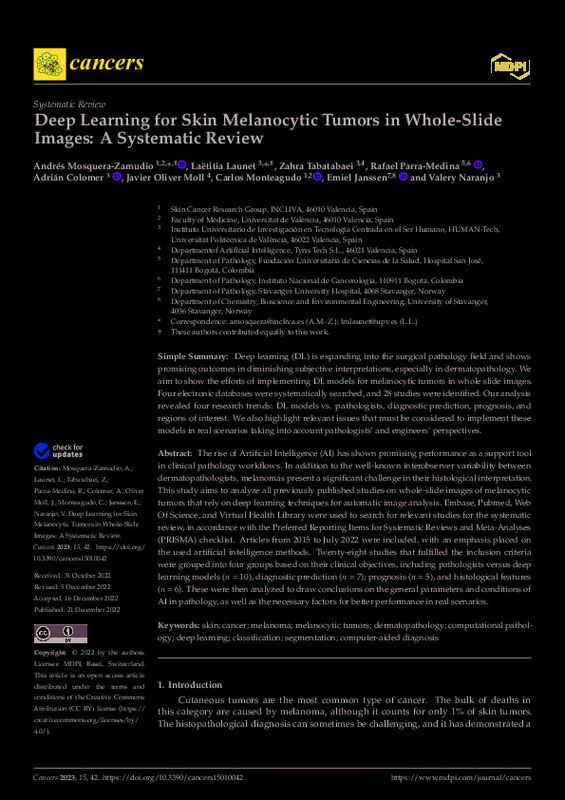JavaScript is disabled for your browser. Some features of this site may not work without it.
Buscar en RiuNet
Listar
Mi cuenta
Estadísticas
Ayuda RiuNet
Admin. UPV
Deep Learning for Skin Melanocytic Tumors in Whole-Slide Images: A Systematic Review
Mostrar el registro sencillo del ítem
Ficheros en el ítem
| dc.contributor.author | Mosquera-Zamudio, Andrés
|
es_ES |
| dc.contributor.author | Launet, Laetitia
|
es_ES |
| dc.contributor.author | Tabatabaei, Zahra
|
es_ES |
| dc.contributor.author | Parra-Medina, Rafael
|
es_ES |
| dc.contributor.author | Colomer, Adrián
|
es_ES |
| dc.contributor.author | Oliver Moll, Javier
|
es_ES |
| dc.contributor.author | Monteagudo, Carlos
|
es_ES |
| dc.contributor.author | Janssen, Emiel
|
es_ES |
| dc.contributor.author | Naranjo Ornedo, Valeriana
|
es_ES |
| dc.date.accessioned | 2023-03-21T19:00:10Z | |
| dc.date.available | 2023-03-21T19:00:10Z | |
| dc.date.issued | 2023-01 | es_ES |
| dc.identifier.uri | http://hdl.handle.net/10251/192533 | |
| dc.description.abstract | [EN] Simple Summary Deep learning (DL) is expanding into the surgical pathology field and shows promising outcomes in diminishing subjective interpretations, especially in dermatopathology. We aim to show the efforts of implementing DL models for melanocytic tumors in whole slide images. Four electronic databases were systematically searched, and 28 studies were identified. Our analysis revealed four research trends: DL models vs. pathologists, diagnostic prediction, prognosis, and regions of interest. We also highlight relevant issues that must be considered to implement these models in real scenarios taking into account pathologists' and engineers' perspectives. The rise of Artificial Intelligence (AI) has shown promising performance as a support tool in clinical pathology workflows. In addition to the well-known interobserver variability between dermatopathologists, melanomas present a significant challenge in their histological interpretation. This study aims to analyze all previously published studies on whole-slide images of melanocytic tumors that rely on deep learning techniques for automatic image analysis. Embase, Pubmed, Web of Science, and Virtual Health Library were used to search for relevant studies for the systematic review, in accordance with the Preferred Reporting Items for Systematic Reviews and Meta-Analyses (PRISMA) checklist. Articles from 2015 to July 2022 were included, with an emphasis placed on the used artificial intelligence methods. Twenty-eight studies that fulfilled the inclusion criteria were grouped into four groups based on their clinical objectives, including pathologists versus deep learning models (n = 10), diagnostic prediction (n = 7); prognosis (n = 5), and histological features (n = 6). These were then analyzed to draw conclusions on the general parameters and conditions of AI in pathology, as well as the necessary factors for better performance in real scenarios. | es_ES |
| dc.description.sponsorship | This work has received funding from the European Union's Horizon 2020 Programme for Research and Innovation, under the Marie Sklodowska Curie grant agreement No. 860627 (CLARIFY). The work is also supported by project INNEST/2021/321 (SAMUEL), PAID-10-21 - Subprograma 1 and PAID-PD-22 for postdoctoral research, and PI20/00094, Instituto de Salud Carlos III, y Fondos Europeos FEDER. | es_ES |
| dc.language | Inglés | es_ES |
| dc.publisher | MDPI AG | es_ES |
| dc.relation.ispartof | Cancers | es_ES |
| dc.rights | Reconocimiento (by) | es_ES |
| dc.subject | Skin | es_ES |
| dc.subject | Cancer | es_ES |
| dc.subject | Melanoma | es_ES |
| dc.subject | Melanocytic tumors | es_ES |
| dc.subject | Dermatopathology | es_ES |
| dc.subject | Computational pathology | es_ES |
| dc.subject | Deep learning | es_ES |
| dc.subject | Classification | es_ES |
| dc.subject | Segmentation | es_ES |
| dc.subject | Computer-aided diagnosis | es_ES |
| dc.subject.classification | TEORÍA DE LA SEÑAL Y COMUNICACIONES | es_ES |
| dc.title | Deep Learning for Skin Melanocytic Tumors in Whole-Slide Images: A Systematic Review | es_ES |
| dc.type | Artículo | es_ES |
| dc.identifier.doi | 10.3390/cancers15010042 | es_ES |
| dc.relation.projectID | info:eu-repo/grantAgreement/EC/H2020/860627/EU | es_ES |
| dc.relation.projectID | info:eu-repo/grantAgreement/UPV//PAID-10-21/ | es_ES |
| dc.relation.projectID | info:eu-repo/grantAgreement/ISCIII/Plan Estatal de Investigación Científica y Técnica y de Innovación 2017-2020 (ISCIII)/PI20%2F00094/ES/ANALISIS COMBINADO POR INTELIGENCIA ARTIFICIAL DE MARCADORES EPIGENETICOS E IMAGENES MICROSCOPICAS DIGITALIZADAS DE TUMORES MELANOCITICOS AMBIGUOS PARA OPTIMIZAR SU CLASIFICACION DIAGNOSTICA Y PRONOSTICA/ | es_ES |
| dc.relation.projectID | info:eu-repo/grantAgreement/UPV//PAID-PD-22/ | es_ES |
| dc.relation.projectID | info:eu-repo/grantAgreement/GVA//INNEST%2F2021%2F321/ | es_ES |
| dc.rights.accessRights | Abierto | es_ES |
| dc.contributor.affiliation | Universitat Politècnica de València. Escuela Técnica Superior de Ingenieros de Telecomunicación - Escola Tècnica Superior d'Enginyers de Telecomunicació | es_ES |
| dc.description.bibliographicCitation | Mosquera-Zamudio, A.; Launet, L.; Tabatabaei, Z.; Parra-Medina, R.; Colomer, A.; Oliver Moll, J.; Monteagudo, C.... (2023). Deep Learning for Skin Melanocytic Tumors in Whole-Slide Images: A Systematic Review. Cancers. 15(1):1-19. https://doi.org/10.3390/cancers15010042 | es_ES |
| dc.description.accrualMethod | S | es_ES |
| dc.relation.publisherversion | https://doi.org/10.3390/cancers15010042 | es_ES |
| dc.description.upvformatpinicio | 1 | es_ES |
| dc.description.upvformatpfin | 19 | es_ES |
| dc.type.version | info:eu-repo/semantics/publishedVersion | es_ES |
| dc.description.volume | 15 | es_ES |
| dc.description.issue | 1 | es_ES |
| dc.identifier.eissn | 2072-6694 | es_ES |
| dc.identifier.pmid | 36612037 | es_ES |
| dc.identifier.pmcid | PMC9817526 | es_ES |
| dc.relation.pasarela | S\480589 | es_ES |
| dc.contributor.funder | European Commission | es_ES |
| dc.contributor.funder | Generalitat Valenciana | es_ES |
| dc.contributor.funder | Instituto de Salud Carlos III | es_ES |
| dc.contributor.funder | European Regional Development Fund | es_ES |
| dc.contributor.funder | Universitat Politècnica de València | es_ES |








